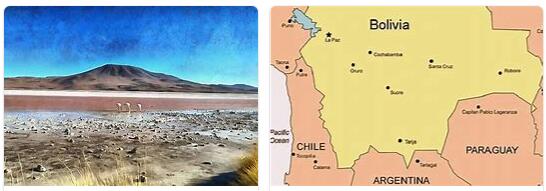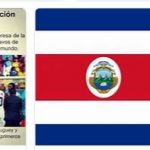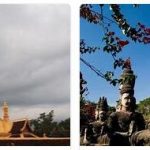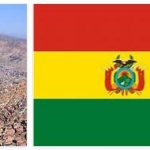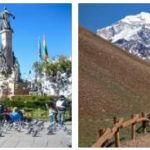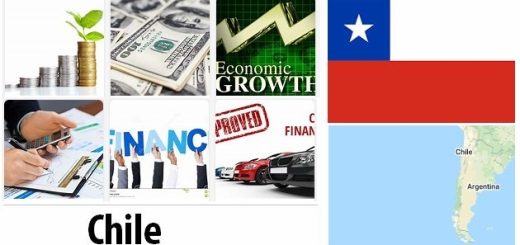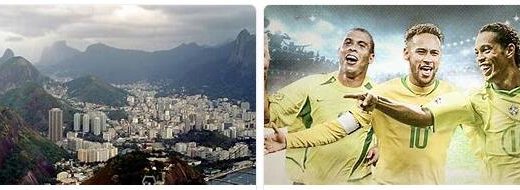Bolivia Country Information
Name
The country owes its name to the freedom fighter Simón Bolívar, who liberated it from the Spanish conquerors in 1825 and became the first president of the newly formed republic. Since 2009 the state name has officially been “Estado Plurinacional de Bolivia” – Pluri-National State of Bolivia.
Location
Bolivia is the only country in the Andes that has no access to the sea. It borders Peru in the northwest, Brazil in the northeast, Paraguay in the east and Argentina in the south. Chile is in the southwest. The north-south extension is 1,500 km, the west-east extension 1,300 km. The area of the country covers 1,098,581 square kilometers. The capital is Sucre , the seat of government is in La Paz.
Time zone
The time difference between Germany and Bolivia is -5 hours in winter and -6 hours during our summer time.
Geography
Bolivia consists of five topographically different regions. Three of these regions are formed by the two Andes ridges, the Cordilleras, and the “Altiplano” plateau in between with Lake Titicaca and the salt lakes. This mountain region covers about a third of the country’s area. The treeless highland steppe in the north slowly turns south into a desert with salt plains. The fourth landscape region is formed by the 300 – 400 m high lowland, the “Oriente”. It makes up most of the country (2/3 of the area). The last region, the “Chaco” belongs to the southern lowlands, but has a completely different vegetation, since at 40 ° C it is one of the hottest areas in South America.
The western Andean ridge has its highest point in the Sajama volcano (6,542 m). The eastern cordillera, which is furrowed by deep valleys (Yungas), rises up to 6,882 m in Illimania, the highest mountain in the country. Between the 800 km wide Andes ridges lies the Altiplano plateau, which has an average altitude of 3,000 m. Lake Titicaca lies in the south of the plateau, but only a small part of it belongs to Bolivia. The area of the two Andean ridges and the plateau make up 35% of the country’s area. In the south of this plain without drainage lies the Salar de Uyuni, a 12,000 square kilometer salt lake, the largest on earth.
History
As early as 200 BC From BC to AD 600, the area around Lake Titicaca was the center of the Tiahuanaco tribe, whose culture is one of the most important prehistoric cultures in South America. This Indian tribe was subjugated by the Incas between 1438 and 1471. The numerous other tribes that had settled in the country in various regions were also defeated by the Incas without much effort. In 1538 the Spaniards came to the country and conquered the entire Andean region. Bolivia and Peru were combined to form the Spanish viceroyalty of Peru in 1563. The Spaniards were particularly interested in the rich silver deposits around Mount Potosí lay. In the 17th century, the area developed into one of the most populous places in America. On August 6, 1825, after the defeat of the Spaniards by the national hero Simon Bolívar, the country proclaimed its independence and named itself Bolivia in his honor. Several upheavals and severe civil wars followed. The country suffered major territorial losses in the so-called Saltpeter War (1879-1883) with Chile when it lost access to the sea with its coastal province of Antofagasta. From 1932 to 1935, Bolivia waged a war with Paraguay in which it lost further territories. Couples, military coups, peasant unrest and social unrest followed again by 2005. In December 2009, the government decided to enter the country Rename “Pluri-National State of Bolivia”.
Flora and fauna
In the arid, barren highlands, the biodiversity is very low. Horst grasses, dwarf shrubs and cushion plants form the vegetation here. In addition to the Andean fox, Andean deer and chinchillas, the condor, a species of vulture with a wingspan of around three meters, is at home here. On the eastern flank of the Andes, orchids, mosses and lichens in particular grow in the cloud forests. The tropical rainforest of the northern lowlands is rich in tropical wildlife including parrots, hummingbirds, tapirs and howler monkeys.
Business
Although Bolivia is rich in natural resources such as silver, tin and oil, as well as natural gas, it has remained a developing country. The situation on the world economic market with the fall in energy and raw material prices has made it the poor house in South America. Trading partners are Brazil, Argentina, the USA, Japan and Venezuela. Natural gas, mining products such as tin and lithium and agricultural products are exported. Above all, food has to be imported because agriculture cannot feed the population. The poor infrastructure hinders industrial expansion and investments from abroad.
Memberships
Bolivia is a member of the United Nations (UN), the Organization of American States (OAS), the Union of South American Nations (UNASUR), the Andean Community ( CAN ), and many other smaller national organizations.
Population
Almost 11 million people live in Bolivia. The majority of them (90%) are members of the most diverse Indian tribes or mixed race between Indians and whites. Whites are in the minority, but form the upper class. The majority of the population now lives in cities, sometimes under inhumane conditions.
Religion
The majority of the population professes the Roman Catholic faith, a small part of the Protestant faith.
Language
In Bolivia, according to the constitution, the 36 regional indigenous languages are also the official language in addition to Spanish. The main ones are Quechua and Aymara. Spanish is mostly spoken in the cities, while the Indian languages predominate in the countryside.
Food and drink
Bolivians prefer spicy food – but the spices and hot sauces are often placed separately on the table. For example, they are very popular in Bolivia
– picante de pollo (chicken with peppers and rice)
– Pique Macho (a mix of meatballs, sausages, rice and vegetables)
– Humitas (corn porridge wrapped in corn leaves)
– Salteñas (filled dumplings)
In Bolivia people like to drink batido, this drink consists of raw eggs and beer. Even if it takes some effort at first, the taste experience is really positive. Another alcoholic drink is chicha, it is beer-like and is obtained by fermenting corn. Otherwise there is also coffee and tea in Bolivia, one of the more typical Bolivian teas is mate de coca, an infusion made from parts of the coca plant.
Medical advice
You can obtain the latest information on vaccinations from your family doctor or the website of the Center for Travel Medicine (CRM).
Entry
All you need to enter Bolivia is a passport, which should be valid for at least 6 months at the time of entry. No visa is required for a tourist stay of less than 90 days. Visit thenailmythology.com for Bolivia travel package.
Current
Since the mains voltage in Bolivia is 110 or 120 volts, it is advisable to take an adapter with you.
Security / drugs
The Federal Foreign Office offers current information on the security situation in the country on its website www.auswaertiges-amt.de/.
Addresses
In Germany:
Embassy of the Plurinational State of Bolivia
Wichmannstrasse 6
10787 Berlin
Tel: 030 – 263915-0
Fax: 030 – 263915-15
E-Mail embajada.bolivia@berlin.de
www.bolivia.de
There are also honorary consulates in Bremen, Hamburg, Munich and Schlossborn.
In Bolivia:
German Embassy
Avenida Acre 2395
La Paz
E-Mail: info@la-paz.diplo.de
www.la-paz.diplo.de
Honorary consulates can also be found in Sucre, Santa Cruz and Cochabamba.
Frequently asked questions about Bolivia
What are the entry requirements for Bolivia?
German citizens do not need a visa for a tourist visit. Upon entry, the passport must be valid for at least 6 months.
What vaccinations do you need to travel to Bolivia?
All travelers who are older than 12 months and intend to travel to areas at risk of yellow fever in Bolivia (in the lowlands east of the Andes) must be able to show a yellow fever vaccination certificate upon request upon entry. It is advisable to always have a vaccination certificate with you, even if you are not visiting areas at risk of yellow fever, as the legal situation and administrative practice do not always match. The vaccination must take place no later than 10 days before entry. In addition, vaccination against tetanus, diphtheria, whooping cough (pertussis) and hepatitis A is recommended, and for long-term stays over 4 weeks also hepatitis B, rabies and typhoid. We recommend taking out health insurance abroad, which should include repatriation.
